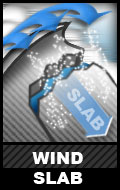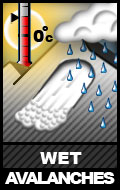The avalanche danger in Chugach State Park has increased due to new snow (a few inches from Saturday night to Sunday morning) and strong winds (that increased and began moving snow Sunday afternoon).
Avalanche Problems:
Click here to learn more about wind slab avalanches
Touchy to stubborn wind slabs, up to D2 in size, will be possible above 2500′ on leeward (primarily NW) aspects and cross-loaded terrain steeper than 35 degrees.
Natural and human triggered wind slabs were observed Sunday in the Peak 3, Arctic Valley, and South Fork Eagle River areas. Rapid wind loading was observed Sunday and winds are currently forecast to be strong through Tuesday.
Obvious signs of wind slab instability will include recent wind slab avalanches, shooting cracks, heavily wind loaded areas of snow that appear bulbous, and hollow snow with denser wind slab over weaker and looser snow.
Click here to learn more about persistent slab avalanches
Isolated, stubborn persistent slabs will be possible on multiple aspects above 2500′ where the snowpack harbors both persistent weak layer and hard slab and terrain is steeper than 35 degrees. Persistent slab problems are expected to be D2 or smaller in size, and most problematic where the snowpack has been further stressed due to recent wind loading.
Two natural D1.5 persistent slabs were observed Sunday in the Arctic Valley area.
The persistent slab problem will be relatively difficult to assess and manage; it requires careful snowpack assessment through snowpits, stability tests, and analyzing snowpack stratigraphy. Recent persistent slab avalanches and whumphing or collapsing of the snowpack will be the more obvious signs of instability.
Click here to learn more about wet avalanches
Wet avalanches, primarily loose wet or sluffs, will be possible on steep (greater than 35 degrees) solar (east to west) aspects above 2500′. These avalanches are expected to be D1 in size and to be of consequence relative to the terrain. The wet avalanche problem will increase later in the day due to warming and the greenhouse effect given expected cloud cover early this week. Direct sun will further contribute to this problem.



